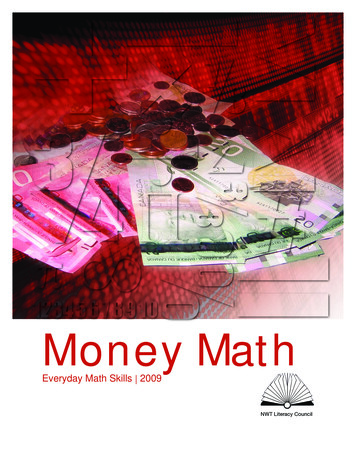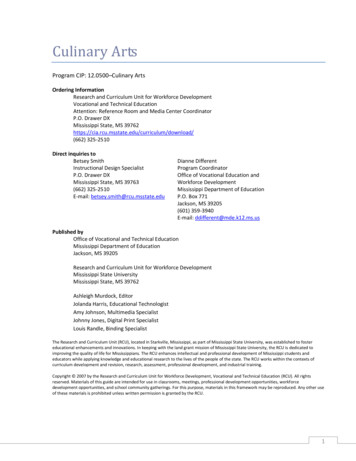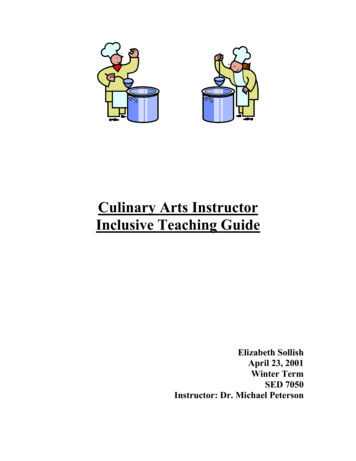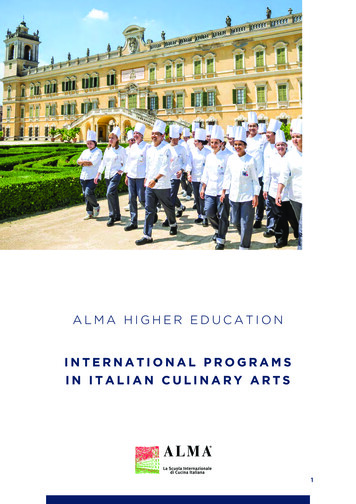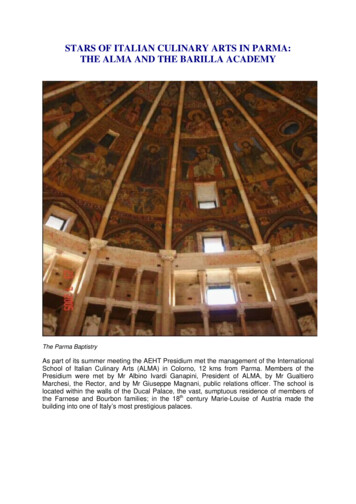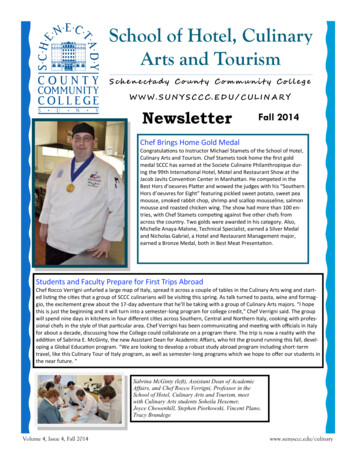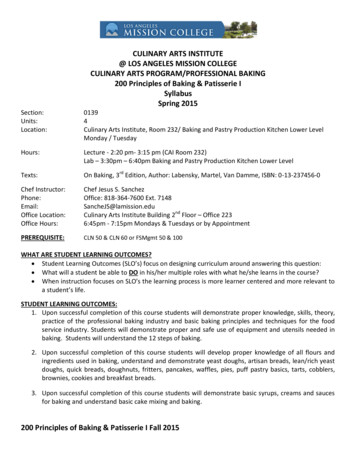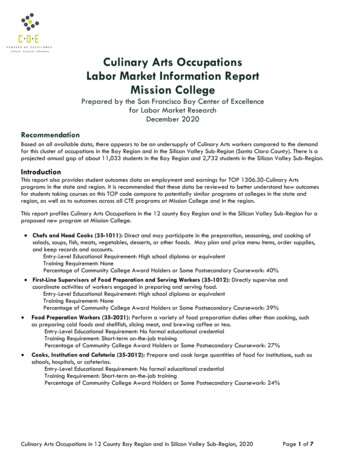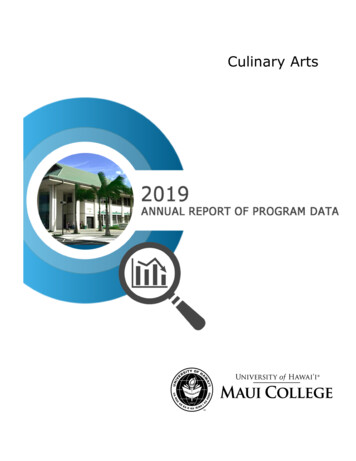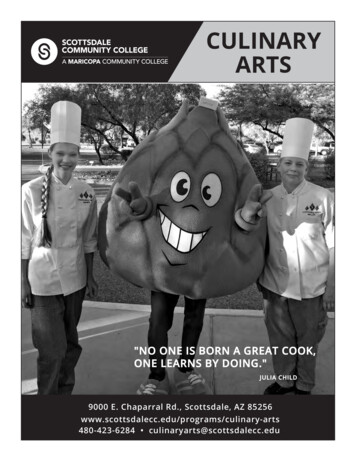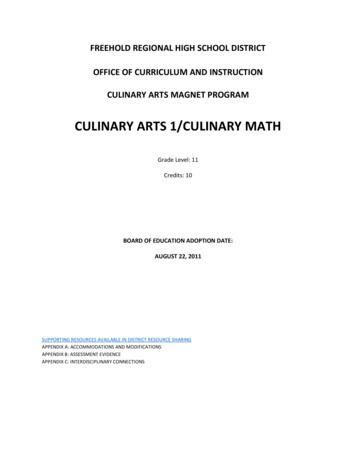
Transcription
FREEHOLD REGIONAL HIGH SCHOOL DISTRICTOFFICE OF CURRICULUM AND INSTRUCTIONCULINARY ARTS MAGNET PROGRAMCULINARY ARTS 1/CULINARY MATHGrade Level: 11Credits: 10BOARD OF EDUCATION ADOPTION DATE:AUGUST 22, 2011SUPPORTING RESOURCES AVAILABLE IN DISTRICT RESOURCE SHARINGAPPENDIX A: ACCOMMODATIONS AND MODIFICATIONSAPPENDIX B: ASSESSMENT EVIDENCEAPPENDIX C: INTERDISCIPLINARY CONNECTIONS
FREEHOLD REGIONAL HIGH SCHOOLDISTRICTBoard of EducationMr. Heshy Moses, PresidentMrs. Jennifer Sutera, Vice PresidentMr. Carl AccettolaMr. William BrunoMrs. Elizabeth CanarioMrs. Kathie LavinMr. Ronald G. LawsonMr. Michael MessingerMs. Maryanne TomazicMr. Charles Sampson, SuperintendentMs. Donna M. Evangelista, Assistant Superintendent for Curriculumand InstructionCurriculum Writing CommitteeMs. Antoinette KovakMs. Sara MarshSupervisorsMs. Cathy Boenig
Introduction - Culinary Arts I/ Culinary MathIntroductionCourse PhilosophyThe Freehold Regional High School District’s Culinary Arts Academy is an occupational, technical and career exploration program that consists of a widerange of courses, training, experiences and activities. It is specifically designed to enhance skills to not only prepare students for employment positionswithin the food industry job cluster, but also for entrance into colleges, culinary colleges, universities or other post‐secondary schools.Culinary Arts I/Culinary Math provide students with the opportunity for “hands‐on” learning through their involvement in all phases of operations inthe licensed restaurant, the 5 Star Café. This furnishes intensive training, with specific job objectives relative to current industry standards and mesheswith the students’ skill abilities and interests.This approach contributes to the development of a well‐ rounded student; one that demonstrates good citizenship, critical thinking and problemsolving skills, sound mental and physical health and the ability to establish personal and professional goals commit to a plan of action to achieve them.Course DescriptionCulinary Arts I/Culinary Math are the first levels of a two‐year course available to juniors enrolled in the four‐ year Culinary Arts Academy Course. It isintended to provide students with a solid foundation, through a combination of direct instruction and practical applications, of the skills necessary tosuccessfully function in a multiphase food service operation. Culinary Math consists of course work, activities, and projects that are specificallydesigned to develop and enhance student knowledge of culinary math as it relates to the food service industry through application in a restaurantsetting.Paramount and foremost is the introduction of federal, state and local mandatory guidelines for the essentials of safety and skill application in acommercial foods environment. The course encompasses basic and advanced culinary arts preparation techniques, inclusive of presentation andproper service.Nutrition is investigated through dietary considerations, cultural foods, and captive audience situations. Food preparation labs are conducted and areinclusive of breakfast, lunch and dinner menu items with specialty baking applications. Dining room service is explored.Students will develop marketable job skill for entry level positions in a variety of fields within the food service industry through their work in a studentoperated licensed restaurant, the 5 Star Café.
Course Map and Proficiencies/PacingCourse l nchmark assessmentsOn Cooking text and ServeSafecourse book chapter readingassignments with chapterquestionsWhat are the guideline andpractices for preparing andserving safe foods?9.4.12. I. (1).89.4.12. I.569.4.12. I.559.4.12. I.519.4.12.I.469.4.12. I.459.4.12. I.439.4.12. I.429.4.12. I.419.4.12. I.409.4.12. I.39Current industrystandards forcommercial foodservice operationsmandate throughunderstanding andeffective applicationof safety andsanitation measuresappropriate for thefacility.Anticipatory setquestionsandWhy is it important toanswer::followedbyfollow safe work placeprocedures and guidelines? class discussionWhat is the role ofgoverning and regulatoryand agencies that governand set standards for allcommercial food serviceestablishments?Why is it important to haveunderstanding of and applybasic math operations asthey apply to culinarytechnology?Survey chapterNRA ServSafe training videosfor food service employeesUnit outline with industrybased hand‐outsPortfolio entries of unitwork including, formal labsheets withsafety/sanitationapplication with gradingrubricChef instructorobservation of applicationof learned material andOutlineState mandatedskill proficiency in thesafety/sanitation test: facility student run restaurant,Review previousbased with 100% accuracythe 5 Star Café/purecareer portfoliogradesanitation labsentries and notebooksNRA ServSafe pre‐testNotebook entriesChef instructor observations: Midterm examinationDaily/weekly grading rubricfor safety/ sanitation andFinal examinationprofessionalism on productionand formal labsHand‐outs: Culinary Academyfacility based rules andguidelines, journals
How did the 18th –early 20thcentury chefs influence theprogression of current daystandardized recipes andmodern day cuisine?9.4.12. I.109.4.12. I.119.4.12. I.129.4.12.I.139.4.12. I.159.4.12. I.199.4.12. I.39.4.12. I.289.4.12. I.299.4.12. I.559.4.12. I.669.4.12. I.699.4.12. I.729.4.12. I.819.4.12.I.99.4.12. I.769.4.12.I.29.4.12.I.8How do advancedtechnology, nutrition, andconsumer trends influencethe modern food serviceindustry?Anticipatory set:What specific jobs inlocal restaurantsProfessionalism inwould have the sameWhat role does a foodthe kitchen brigadeor similar jobservice manager and otherand front housedescriptions as theprofessionals, such asrestaurant mirrors“station assignments”dietitian, food scientist andthe industryin the student runfood journalists play in thestandards of therestaurant, the 5 Starfront and back house foodNational RestaurantCafé?service operation?AssociationSurvey Chapterguidelines andWhy is record‐keepingOutline Hand‐out andregulations.important for food servicereview notebook/operations?portfolio entriesWhy is it important tounderstand and applyperpetual and physicalinventory control?How do you interpret aninvoice and what and whatare the various parts of aninvoice?On Cooking, (classroom text)chapter reading assignment/questions.Unit outlineDirect instructionNote‐takingPortfolio entries of unitwork, formal lab sheets,picturesand documentation ofcommunity serviceprojects/workTeacher observation ofprofessional workattitudes and skillproficiency in student runrestaurant the 5 Star CaféTeacher observation ofdemonstrated professionalismthrough daily/weekly grading Research project:rubricProfessionalism in thefood service industryResearch professionalism inrelation to front and backMidterm examinationWhat informationneeds to be entered? house positionsFinal examination
What nutrition and menuplanning role do starches,grains and pastas, play instandardized recipepreparation?9.4.12. I.159.4.12. I.39.4.12. I.289.4.12. I.299.4.12. I.559.4.12. I.669.4.12. I.699.4.12. I.729.4.12. I.819.4.12.I.99.4.12. I.129.4.12. I.769.4.12. I.109.4.12.I.89.4.12. I.199.4.12. 4.12.I.629.4.12.I.56How do you developstandardized recipes for afood service operation?What are the classiccategories of stocks, soups,and mother sauces and howare they used tocompliment basic proteinsReview of careerof poultry, seafood andportfolio entries:meat in a menu and foodnotebook entries/production?formal labs withIdentifyingverbal pre‐testterminology andWhat are the scientific andcharacteristics ofmathematical implicationscooking principles ison all cooking applicationsnecessary to developto produce a saleableadvanced culinaryReview a varietyproduct throughpractices and skillvideos of basicstandardized recipeproficiencies.cooking applicationpreparation?with post‐testWhat are the implications ofmatching small wares,measuring devices, andequipment for all cookingtasks and standardizedrecipe preparation?What are the methods usedfor portion size?How should you estimatepreparation amounts andthe number of servingportions?Do now Math: standardizedRecipe yields/ conversionsOPEN ENDED QUESTIONS:product development andproduction for saleableproductsRecipe developmentprojectUnit outline/note‐takingPortfolio entriesFormal and production labsMidterm examinationChapter quiz/testsFinal examinationChef instructorobservation/professionalismgrading according todaily/weekly rubric
On Cooking chapter readingassignments with relatedchapter questions/activitiesWhat skills are needed tomake an informed careerdecision in food service?9.4.12. I.169.4.12. I.309.4.12. er explorationand managementactivities applied tothe kitchen brigadeprovide informeddecisions forprofessional jobopportunities andcareer planning.What would be a logicalcourse of action to exploreculinary and managementpositions such as roundsman/short order line cookor quantity bakerconsidering the task analysisor job descriptions?Unit outlineGuest speakers andPortfolio entriesAnticipatory setquestionsSkill ability/careerinterest surveyHow would you gainknowledge of businesscommunications incommercial food serviceoperations?demonstratorsResearch action projectDirectinstruction/demonstrationswith student note‐takingFormal/production labsMidterm examinationFinal examinationUnit quiz/ testTeacher observation withdaily/weekly gradingaccording to rubricCommunity service work9.4.12.I.39.4.12. 4.12.I.629.4.12.I.669.4.12.I.56What are the agenciesguidelines, organizationsand cultural considerationsthat influence thecommercial food serviceindustry?Basic concepts ofnutritional foodscience areinherently thefoundation forproductdevelopment andmenu delivery.How do nutritional choices Anticipatory seteffect product development questionsand menu delivery?Pre‐testHow do the five sensesinfluence seasonings andflavorings in product/recipedevelopment andadjustments?What is the purpose ofrecord keeping in a foodservice establishment?On Cooking chapter readingassignments with relatedchapter questions/activitiesInternet researchUnit outlineDirect instruction/demonstrations/ with notetakingUnit test/ quizzesFormal/production labsTeacher observations withdaily/weekly gradingaccording to rubricStandardized recipe andnutrition projectPortfolio entriesMidterm examinationFinal examination
9.4.12. standing ofmathematicalfundamentals andfunctions in thehospitality and foodindustry.What mathematical skillsare necessary for the foodservice industry?What is the importance ofmenu pricing and what arethe factors that influencemenu pricing?Anticipatory setquestionsCulinary Math questionsrelated to formal labs andproductionQuizzesRecipe conversionsRecipe developmentprojectMidterm examinationFinal examinationProficiencies and PacingUnit TitleUnit Understanding(s) and Goal(s)Recommended DurationCurrent industry standards for commercial food service operations mandate throughunderstanding and effective application of safety and sanitation measures appropriate forthe facility.Unit # 1: IndustryStandards for Safetyand SanitationThe student will:1. Identify and recognize the role of all governing agencies, regulations and guidelines thatwould affect the safe and sanitary production of food and the facility.2. Establish criteria to maintain a safe and sanitary workplace recognizing Hazard Analysis 4 weeksOn goingCritical Control Point standards.3. Recognize and practice set standards for receiving, storing, handling and serving safefood.4. Demonstrate a professional and proactive role in safety and sanitation procedures in thestudent run restaurant, the 5 Star Café.5. Demonstrate an understanding of and apply basic math operations as they apply toculinary technology.Professionalism in the kitchen brigade and house restaurant mirrors the industry standardsof the National Restaurant Association guidelines and regulations.Unit # 2:Professionalism in theKitchen Brigade andFront HouseRestaurantThe student will:1. Examine the importance of job descriptions and task analysis to maintain an acceptable 7 weekslevel of professionalism in the Kitchen Brigade and Front House Restaurant.On going2. Recognize and practice skill and management activities according to currentprofessional level industry standards.Demonstrate a professional and proactive role in all tasks and assignments in the dailyoperation of the student run restaurant, the 5 Star Café.
Identifying terminology and characteristic of cooking principals is necessary to developadvanced culinary practices and skill proficiencies.The student will:1. Identify and classify the advanced preparation of foods in the categories of Starches, grains and pastaUnit # 3: Advanced Stocks, soups and mother saucesFood Preparation Poultry, seafood and meats2. Summarize reasons for cooking foods.3. Examine appropriate heat application methods.4. Prepare foods for advanced cooking through proper processing and treatmentmethods.Integrate the proper use of small wares, measuring devices and equipment for all cookingtasks and standardized recipe preparation.Career exploration and management activities applied to the kitchen brigade provideinformed decisions for professional job opportunities and career planning.The student will:1. Identify and classify the kitchen brigade job descriptions and task analysis for: Rounds man and short order line cookUnit # 4: Career Pantry, salads and cold foods cook.Exploration and Commercial bakerManagement.2. Recognize personal qualities and abilities with practical application skills appropriatefor breakfast / lunch cooks and the related management duties.3. Match the components of standardized recipes with appropriate kitchen stations andbrigade personnel.4. Identify the appropriate pre prep; prep and mise in place for each kitchen station.5. Explore and apply in a professional manner learned skills to the daily operation of thestudent run restaurant, the 5 Star Café.7 weeksOn going
Basic concepts of nutritional food science are inherently the foundation for productdevelopment and menu delivery.Unit # 5: NutritionalFood ScienceThe student will:1. Summarize and explain basic nutritional concepts.2. List basic food science concepts such as heat applications, the process of osmosis as itrelates to salting foods; acid/ alkaline solutions and analyze the effects when applied toproduct development.3. Evaluate the principles of nutritional cooking.4. Explain the role of the five senses in tasting and describing the flavor of foods5. Rationalize the factors for scaling a standardized recipe.7 weeks6. Define flavorings and seasonings with relation to product development.On going7. Analyze the factors for selecting measurement tools/techniques appropriate forproduct/recipe development or adjustment.8. Compile and analyze menu and dietary guidelines with cultural influences.9. Recognize the guidelines and recommendations of the United States Department ofHealth and Human Services (DHHS), the American Diabetes Association (ADA), the WorldHealth Organization (WHO) and the American Heart Association (AHA) and their influenceon commercial food service.10. Test and evaluate original standardized recipes in the student run restaurant, the 5 StarCafé.Understanding of mathematical fundamentals and functions in the hospitality and foodindustry.Students will:1. Perform basic math functions relating to the food service industry.Unit # 6: Culinary Math 2. Methods for accurately weighing, measuring and portioning.3. Procedures for costing and converting a standardized recipe.4. Use computer programs to record information needed to run a food service operation.5. Develop food production reports for the various stations in a commercial kitchen.6. Take a physical inventory for the 5 Star Cafe and record results on an inventoryspreadsheet.3 weeksOn going
Unit 01 - Culinary Arts I/Culinary MathIndustry Standards for Safety and SanitationEnduring Understandings: Current industry standards for commercial food service operations mandate a through understand and effectiveapplication of sanitation and safety measure appropriate for the facility.Essential Questions:What are the guideline and practices for preparing and serving safe foods?Why is it important to follow safe work place procedures and guidelines?What is the role of governing and regulatory and agencies that govern and set standards for all commercial food service establishments?Why is it important to have understanding of and apply basic math operations as they apply to culinary technology?Unit Goal: The students will recognize and demonstrate professional safety and sanitation practices according to industry standards.Duration of Unit: 4 weeks and on going
rces and Materials Suggested StrategiesSuggestedAssessmentsLecture, class discussion and application of theCulinary Academy’s Facility Based guidelines andRules for Safety and SanitationRead, analyze and answer review questions inthe National Restaurant Association’s ServSafeCourse bookHow do food, acidity, time,temperature, oxygen andmoisture (FATTOM)influence commercial foodservice?ServSafe course bookCompare academy standardsStudent portfoliofor professional and goodpersonal hygiene to the NRAServSafe guidelines and NJNewspapersBoard of Health code 12, todetermine complianceProfessional journal andnewslettersUnderstand and follow allgoverning regulations andVideosguidelinesEstablish the criteria tomaintain a safe workplaceRead and analyze the safety/sanitation chaptersof at least two Culinary Academy textbooks.Prepare and list of the facts and/or concepts thatappear most important as they are emphasized inall texts that were reviewedReview and evaluate Local Board of Healthevaluation of the facilityWritten tests andquizzesPass with 100%accuracy a facilitybased safety andsanitation testWorksheetProject assessmentsDemonstrations for Introduction to CommercialFoods (Peer Teaching)Formal and productionlab safety/sanitationassessment criteriaView and evaluate Culinary II Safety andSanitation Management projects: posters and/orpower point presentationsArticle summariesInstant read thermometers Properly “set up a pot sink”. Check and recordtemperatures and chemical levelsTest stripsPrior to beginning the assigned station mise enFormal and production Lab place, record refrigeration and foodmaterials and suppliestemperatures on log sheetsCheck temperatures of stored and preparedfoods. Record and check with regulatory agencyguidelines if temperatures are outside of thedanger zoneRole model proper dress and personal hygienefor safetyDemonstrate safe food handling and storingpractices at all times including labeling andproper storage containersNotebook assessmentsResponses todiscussion questionsJournal assessmentsDaily grade accordingto rubric for safety andsanitation as per chefinstructor professionalobservation
Direct instruction, class discussion andapplication of the Culinary Academy’s FacilityBased Guidelines and Rules for Safety andSanitationRead, analyze and answer review questions in theNational Restaurant Association’s ServSafeCourse bookWritten tests andquizzesServSafe course bookStudent portfolioWhat role does the NewJersey Sanitary Code:Chapter 12 play in servingsafe food in commercialfood establishments?Demonstrate continuedaccuracy (100%) in safetyand sanitation proceduresfor receiving, storing,handling and s
Aug 22, 2011 · Paramount and foremost is the introduction of federal, state and local mandatory guidelines for the essentials of safety and skill application in a commercial foods environment. The course encomp

